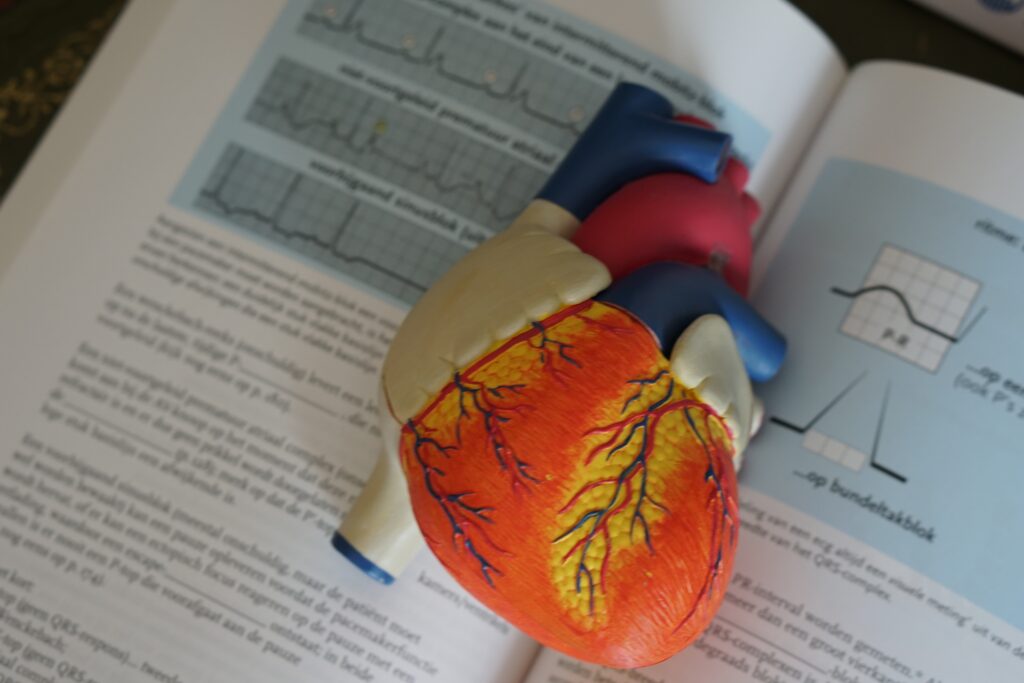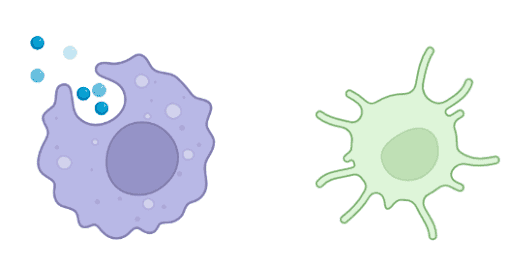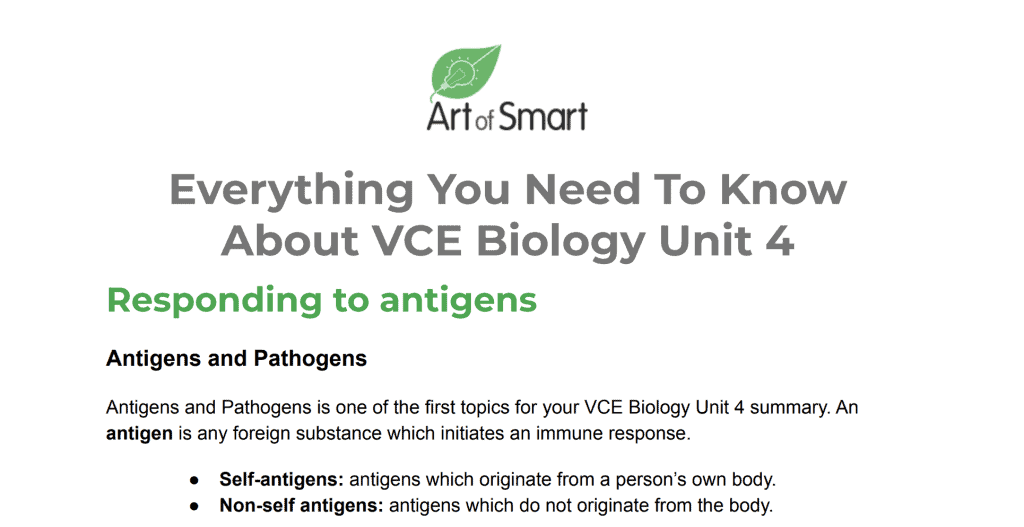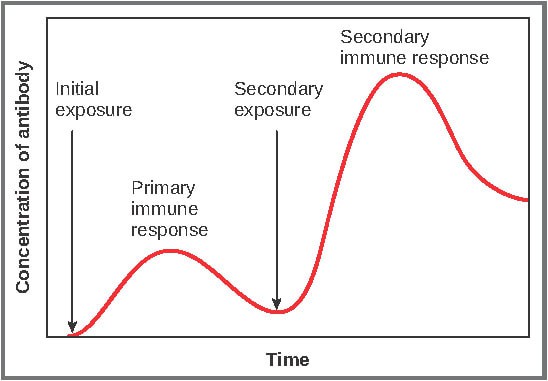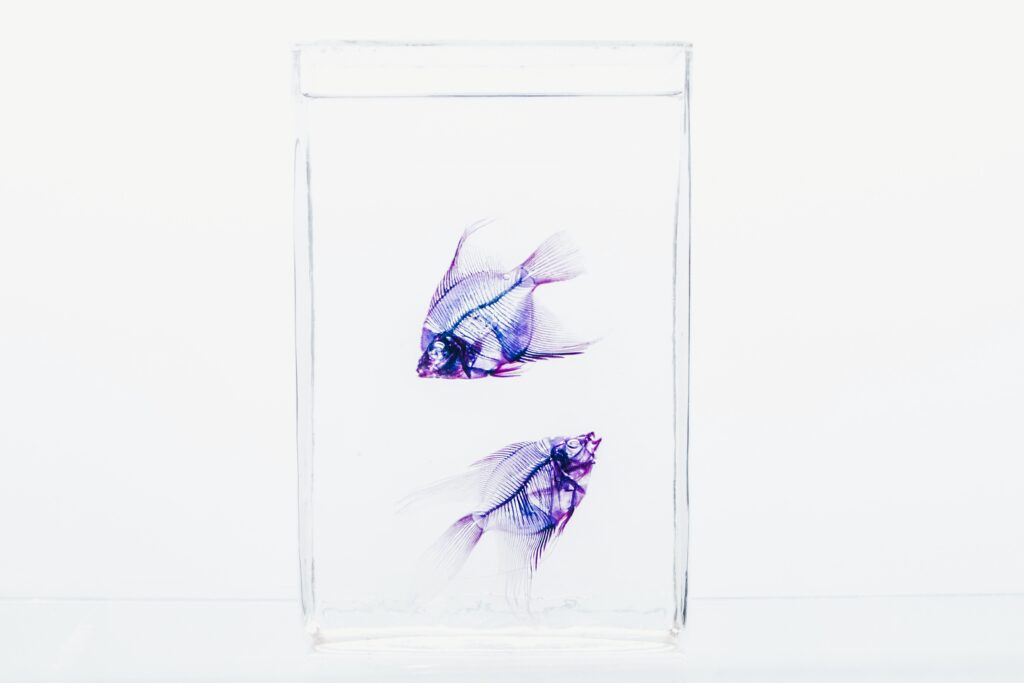Aced your Unit 3 of VCE Biology and are about to start working on your VCE Biology Unit 4 summary?
Let’s make studying for this final unit of Biology a little simpler and check out our topic-by-topic summary of you’ll be learning on this last stretch!
Ready to get started? Let’s go!
Responding To Antigens
Genetic Changes In a Population Over Time
Experimental Design
Responding To Antigens
Antigens and Pathogens
Antigens and Pathogens is one of the first topics for your VCE Biology Unit 4 summary. An antigen is any foreign substance which initiates an immune response.
- Self-antigens: antigens which originate from a person’s own body.
- Non-self antigens: antigens which do not originate from the body.
A marker of self is found on the MHC I protein. This is a surface-bound protein found on all nucleated cells (i.e. any cell that is not a red blood cell).
The body is usually able to distinguish between its own MHC I markers, and a foreign MHC I marker, and can use this to differentiate between self and non-self.
A group of non-self antigens include pathogens. These are causative agents of disease, and are described as either cellular or non-cellular.
Cellular pathogens: pathogens which have a cell (as the term suggests!). Examples include:
- Bacteria: Prokaryotic unicellular organisms. Note that not all bacteria are pathogenic. Bacterial infections are treated with antibiotics
- Fungi: Eukaryotic organisms which may be unicellular or multicellular. Contain a chitin cell wall, and are usually not pathogenic
- Protists: Eukaryotic unicellular organisms. Highly diverse.
Non-cellular pathogens are not made of cells. These include:
- Viroids: A single strand of RNA that lacks a protein coat. These only infect plants.
- Prions: Infectious proteins which lack nucleic acid. A normal protein can become a prion if they come into contact with each other. Examples include Mad Cow’s disease and Kuru.
- Viruses: An infectious agent which can only reproduce inside a host cell. Contains a nucleic acid core as well as a protein coat. Viruses are unable to reproduce by themselves due to a lack of ribosomes, and they have no other way of reproducing – because of this, they are called non-living.
The First Line of Defence
You’ll also study the lines of defences in your VCE Biology Unit 4 summary.
In order to successfully infect an individual, a pathogen must breach several lines of defence. The first line of defence is comprised of physical, chemical and microbiota barriers.
In plants:
- Physical barriers include a cuticle, epidermal layer, hairs, thorns and galls which block entry, much like a shield
- Chemical barriers include production of enzymes, toxins, and antibacterial/antifungal agents. Generally, these will break down pathogens.
In animals:
- Physical barriers include intact skin, mucous membranes and cilia/hair.
- Chemical barriers include stomach acid, lysozyme (not lysosomes) and other natural secretions
- The microbiota refers to the commensal bacteria (i.e. helpful bacteria) found in an animal. This helps defend against pathogens, for example by competing for nutrients, blocking access to cells, or producing antimicrobials.
The Second Line of Defence
If an antigen breaches the first line of defence, the body elicits an innate immune response. The response is identical against all antigens, and is relatively quick.
There are many cells and molecules involved in the innate immune response. In general, “white blood cells” are called leukocytes – these are the cells involved in immunity.
Macrophages will engulf, digest and destroy an antigen. Their main purpose is in destroying antigens and removing them from the body system.
Neutrophils fulfil a very similar function – neutrophils are notable in their speed and that they are the most common leukocyte. They also release antimicrobial compounds that disrupt and break down bacteria/fungi and other pathogens
Dendritic cells are again similar to macrophages, however dendritic cells have a greater role in antigen presentation. They have a high surface area : volume ratio, which helps them with this function.
Eosinophils can engulf, digest and destroy antigens, though their function is more strongly associated with release of cytotoxic chemicals and cytokines. Their activity is highest during parasitic infections.
Natural killer cells will detect virally infected cells and release compounds such as perforin, to puncture the cell wall. This ultimately leads to the death of these virally infected cells. Natural killer cells also release cytokines to signal other immune cells.
Mast cells are involved in the inflammatory response. Specifically, they will release histamine to induce a variety of effects.
Complement proteins are a set of over 30 proteins that work together to eliminate antigens. For example, they can form a membrane attack complex to lyse an invading cell, or increase antibody affinity. Activity is enabled by a cascade of events.
Note: These also participate in the adaptive immune response
Interferons are cytokines which are produced by virally infected cells. Overall, they function to protect virally-infected cells, for example by blocking translation, which prevents translation of viral proteins, or by attracting other cells such as natural killer cells.
Image Created and Sourced From Biorender
The Inflammation Response
The inflammation response is elicited in an attempt to remove an invading agent from the body.
It results in the accumulation of fluids, leukocytes which can be seen by swelling, redness, pain and heat.
The steps involved are as follows:
- The antigen breaches the first line of defence, for example entering via a cut
- Cells release cytokines which attract phagocytes, and in particular neutrophils and mast cells to the site of infection
- Mast cells release histamine, causing vasodilation (dilation of blood vessels) and increasing blood vessel permeability (i.e. leaky).
- Increased permeability enables leukocytes and other fluids (which contain complement/other molecules) to enter the site of infection
- One such leukocyte are macrophages which will engulf, digest and destroy the invading antigen
Adaptive Immunity
Overall, this is an immune response that is specific against the antigen.
It tends to be slower, however generates memory against future infections (unlike the innate immune response).
There are two overall branches:
- Humoral response, involving both B and T lymphocytes. This is a response against extracellular pathogens
- Cell-mediated response, involving the T lymphocytes. This is a response against intracellular pathogens.
Lymphatic System
Some of the key cells in the lymphatic system include:
- B lymphocytes
- T lymphocytes
- Antigen presenting cells
Other important structures include:
Lymphatic vessels: Carries lymph throughout the rest of the body. Contains valves to ensure unidirectional flow of lymph.
Primary lymphoid organs: Where lymphocytes mature. The site of B lymphocyte maturation and includes the bone marrow. Is also the site where both B and T lymphocytes originate from.
Also includes the thymus, where T cells will migrate from the bone marrow and complete maturation in the thymus.
Secondary lymphoid organs: The site of antigen presentation After maturing, B and T lymphocytes are referred to as naive. They become activated after antigen presentation
Includes the spleen and other lymph nodes
Antigen Presentation
This is the key step that connects innate and adaptive immunity.
The overall goal is the activation of a T helper cell, which goes on to assist other cells in the adaptive immune system.
Below, we discuss the steps in the context of a dendritic cell, but it can be applied to other antigen-presenting cells as well.
- A dendritic cell will engulf and digest an antigen.
- The dendritic cell presents the antigen on an MHC II. This is found only on antigen-presenting cells, including dendritic cells, macrophages and eosinophils.
- A T helper cell that binds specifically to the MHC II / antigen complex will arrive
- Cytokines and other factors released by the dendritic cell then activates the T helper cell
Humoral Response
The humoral response is activated when:
- A mature, naive B lymphocyte encounters a specific antigen, and binds to it
- The naive B lymphocyte becomes activated by an already activated T helper cell (from antigen presentation)
- The B lymphocyte divides and differentiates into plasma and memory B cells.
The plasma cells will release antibodies which act specifically against one antigen.
Antibodies are quaternary proteins comprised of two heavy chains and two light chains. They contain a constant region, which dictates some basic function, but also a variable region which dictates which antigen they can bind to (via the antigen binding site).
Image Sourced From Arizona University
Antibodies do not destroy antigens directly, instead either disrupting the antigen functioning, or recruiting other molecules/cells to assist:
- Precipitation, forcing the antigen out of a solution
- Activation of a complement protein attack, which may cause lysis
- Agglutination, where antigens clump up for more efficient phagocytosis
- Neutralisation, involving binding to toxins or other molecules, preventing those toxins from causing damage.
B Memory Lymphocytes
These cells reside in the lymph node.
If they bind to their specific antigen, they will then differentiate into plasma cells to create a quicker and stronger response.
Cell-Mediated Response
As part of antigen presentation, when the T cell is activated, it will also proliferate into cytotoxic T cells.
Each T cell receptor is specific for one antigen.
Helper T cells assist other cells, for example, via cytokine production that can direct other lymphocytes or assist with activation.
Cytotoxic T cells will recognise a virally infected cell, based on that cell’s MHC I. Upon recognition, it will release perforins to puncture the cell wall, much like a natural killer cell.
Memory T cells are produced afterwards. If they bind to its specific antigen, the memory T cell will proliferate to ensure a faster response the second time.
Types of immunity
Active immunity involves the host’s adaptive response. This takes time to activate, however leads to lifelong memory.
- Natural active immunity may occur via normal exposure to a pathogen
- Artificial active immunity may occur via vaccination
A vaccine may be composed of an attenuated, or weakened, form of the pathogen, or a component of a pathogen. Upon exposure to this pathogen, the body launches an adaptive response.
This results in induction of memory B and T cells, thus leading to a quicker and stronger response for subsequent exposures.
Once a sufficient proportion of the population is vaccinated, this makes it harder for a pathogen to find any host to replicate in. As a result, the pathogen will not be able to successfully transmit between vulnerable hosts, and the amount of pathogen in the population will decrease over time.
This is the idea of herd immunity, which describes the concept that the population will gain overall resistance to a pathogen after a high enough portion of the population has received the vaccination.
Image Sourced From Lumen Learning
Passive immunity does not involve any adaptive response. It is much quicker, however does not lead to lifelong memory.
- Natural sources include placental antibodies, which are transferred from the mother to the foetus
- Artificial sources include inoculation of antibodies or antitoxins, for example to treat a snake bite.
Pathogens In a Globally Connected World
When considering disease challenges in your VCE Biology Unit 4 summary., think about both:
- New pathogens
- Re-emerging pathogens. This may occur if a pathogen acquires a gene that makes it more virulent for example
- Pathogens can easily arrive in a country for the first time due to globalisation — such as a passenger on a plane or ship may be carrying a virus. Upon landing, this passenger is then able to transmit this pathogen to other people.
Example: European arrival and the effect on First Nations peoples. Europeans had immunity against diseases such as smallpox and measles. However, this was not the case for First Nations people, who had not been exposed to these pathogens before. Arrival of Europeans also meant arrival of these pathogens, leading to widespread disease in the First Nations population.
In some cases, this can lead to an epidemic or pandemic.
- An epidemic is a sudden increase in a disease in a local area
- A pandemic is a sudden increase in a disease at a global proportion.
Controlling Disease
To control a disease, we need to:
- Identify the pathogen and host
- Identifying the pathogen could be done, for example via an enzyme-linked immunosorbent assay (ELISA), which will identify antibodies specific to the pathogen in a person. Another option involves DNA sequencing, where we determine the genome of the pathogen
- Determine the mode of transmission
- Some pathogens transmit via the airborne route, others may transmit via the faecal-oral route for instance. Different pathogens may also have very unique transmission patterns.
- Determine an appropriate method to control transmission
- For an airborne pathogen, wearing masks may help prevent transmission
- It is also important to educate people about why certain measures are being implemented
- Vaccinations are another good option to control transmission.
Immunotherapy Strategies
Monoclonal Antibodies
Monoclonal antibodies are antibodies which are specifically engineered to achieve a particular purpose.
Considerations include the structure of the antibody binding region, which needs to be specific to the target The constant region, which can affect properties of the antibody such as how easily it can access a particular area
Monoclonal antibodies can be used for autoimmune diseases as well as cancer.
- Autoimmune diseases are diseases caused by the body’s own immune cells attacking “self” cells. Monoclonal antibodies could be used to inhibit cytokines or immune cells that are causing damage
- Cancers represent a set of diseases due to uncontrolled cell growth. Monoclonal antibodies could be used to target growth factors, or could also be used to assist the immune system with removing cancerous growths.
Genetic Changes In a Population Over Time
The second area of study for your VCE Biology Unit 4 summary addresses the genetic changes to a population.
- Gene pool: The total set of alleles found in a given population
- This can be described in terms of allele frequencies and the relative proportion of that allele.
Factors that can affect allele frequencies include:
Environmental selection pressures: Factors in the environment which can make certain organisms more likely to survive than others.
For example, a higher temperature will make organisms that can tolerate higher temperatures more likely to survive.
Natural selection describes how this occurs. There is innate genetic variation in a population
Organisms with a beneficial phenotype are more likely to survive and reproduce to pass on their beneficial alleles
Over time, this leads to changes in allele frequencies.
Genetic drift: Random chance events that affect allele frequencies. These have a larger effect on smaller populations. This includes:
- Bottleneck effect: A random event which significantly reduces the population size, often leading to loss of alleles
- Founder effect: Where a small group of individuals establish a new population in a new location. The gene pool reflects the allele frequencies of this small group.
Gene flow: Migration of individuals into and out of a population leads to introduction or removal of alleles from a gene pool
An important consideration with the gene pool is the genetic diversity.
A population with higher genetic diversity is more likely to survive than a population with low genetic diversity. This is because higher genetic diversity grants a population the ability to adapt to a wide range of selection pressures.
Mutations
Mutations are changes in nucleotide sequence, which may arise from faulty DNA replication for example.
While faulty replication is an example of a spontaneous mutation, mutagens can increase the rate/chance of mutations occurring. These include UV rays or chemicals.
Mutations can only be passed onto offspring if these mutations occur in germline cells.
Have a week until your Biology exam comes along? Check out our 7 day study plan here!
Point mutations
Point mutations are mutations which a change to a single base in DNA. This can include a substitution (the base is changed, e.g. A -> C), insertion (a new base is added), or deletion (a base is deleted). Point mutations can additionally be categorised into:
Silent mutations: Lead to no change in amino acid sequence.
Missense mutations: Leads to a change in amino acid sequence. This can be conservative (protein can still function), or non-conservative (protein is no longer able to function).
Nonsense mutation: Leads to a change into a stop codon. This ends the amino acid sequence.
Frameshift mutation: Where the reading frame is altered. That is, triplet reading has changed by one base.
Block mutations
These are mutations that affect segments of a chromosome. These are the result of errors in meiosis, and leads to significant change in genes. Examples include:
Inversion: A segment is removed and replaced in the reverse order
Duplication: A segment is copied
Translocation: Segments in two different chromosomes are swapped
Deletion: A segment in a chromosome is removed altogether
Chromosomal Abnormalities
These involve the addition, or entire absence, of a whole chromosome. We usually have two sets of 21 chromosomes, on top of 2 sex chromosomes.
Aneuploidy is the addition/absence of a chromosome. For example, a person might have an extra chromosome 21, or not have an X chromosome.
Polyploidy is the addition of entire sets of chromosomes (i.e. 3 or more copies of chromosomes).
Selective Breeding
Humans may be interested in manipulating gene pools to our own benefit. For example, we may grow plants that specifically have higher fruit yield.
- Select organisms with the favourable trait
- Force these organisms to reproduce, thus passing on the favourable alleles
- Over time, the population will be made of organisms with the favourable trait
This does have negative consequences such as reducing genetic diversity, which may lead to increased disease susceptibility.
Evolution In Bacteria and Viruses
A key treatment option against bacteria are antibiotics, which target structures specific to bacteria to kill the pathogen.
- Antibiotics have functioned as a selective pressure. This favoured bacteria that had genes granting antibiotic resistance, so these bacteria passed on these genes. Over time, bacteria have developed increasing amounts of resistance, leading to us running out of antibiotics to treat bacteria.
Viruses are also capable of evolution. Two example are:
- Antigenic drift, where a viral protein (an antigen) changes structure.
- Antigenic shift, where a new antigen (e.g. a new combination of proteins in the influenza virus) is created
For your VCE Biology Unit 4 summary, these events are noteworthy because vaccines are designed to target a specific antigen. Therefore, when these events occur, old vaccines will not work as well, so new vaccines will need to be developed.
Changes In Species Over Time
Fossils and the Fossil Record
Fossils are the remains or traces of an organism from the past. Fossils include bones, footprints or other tracks for example.
When estimating how old a fossil is, there are two techniques that are used: relative dating, and absolute dating.
Note: Relative dating involves investigating fossils in terms of other index fossils, or the strata layer. Index fossils are “model fossils” (e.g. because of their abundance and distribution), which can be used to date other fossils in the same strata.
By analysing the sequence of fossils in strata (i.e. which fossils are deeper), it becomes possible to determine which fossils succeeded which others.
Absolute dating can be achieved by exploiting radioactive decay. Based on how much radiation a fossil emits, it is possible to conclude how old the fossil is.
Fossil formation requires a few conditions:
- Rapid burial
- Protection against erosion and other environmental damage
- Low oxygen
- Hard body part
In some cases, we can find transitional fossils, which are fossils that display characteristics of an older and newer species (i.e. an ancestor and its descendent). This is an indication of a species changing over time.
Speciation
Speciation in general refers to processes that lead to new species.
A species is defined as a group of organisms that can interbreed to produce fertile and viable offspring. Fertile means that these organisms are also capable to preproducing. Viable refers to being able to live.
In your VCE Biology Unit 4 summary, two examples that you will need to know are:
Allopatric speciation: For example, Galapagos finches. Originally, these finches would have existed as a single population. However, a geographic barrier led to to separation of these populations – that is, no gene flow occurred between these populations. On either side of this barrier, there were different selective pressures (mainly the different foods), therefore leading to different phenotypes over time via natural selection. Eventually, this gave rise to new species
Sympatric speciation: For example, Howea palms. Unlike allopatric speciation, these palms are found in the same geographical location. However, different species of palms flower at different times, meaning they never interbreed. Over time, this will lead to reproductive isolation.
Phylogenetic Trees
Phylogenetic trees are diagrams which depict how closely related various species are. For your VCE Biology Unit 4 summary, you can refer to this phylogenetic tree:
To interpret phylogenetic trees, the most important things to consider are branching points (indicated by when one line splits into two lines). The length of the “branch” (the horizontal line) denotes a relative amount of time.
For instance, chimpanzees are more closely related to bonobos than humans.
To work this out, we would look at the “last common ancestor” between chimpanzees and bonobos – in other words, where is the point where they branch into different species?
This occurs at point A. Then, we would do the same for humans and chimpanzees. We see that they branch at point B. Because A is more recent than B, chimpanzees are more related to bonobos than humans.
Test your knowledge and check out our master list of VCE Biology past papers here!
Structural Morphology
Analysing the functions and anatomy of structures can give insights into how species evolved.
- Homologous structures have different functions, but have morphological similarities. This suggests that the species had a common ancestor (due to the morphological similarity), but later speciated due to different selective pressures (evidenced by the different function)
- Vestigial structures are structures which have lost their function. Vestigial structure may exist because an ancestral species had a functional structure.
Molecular Homology
Mutations are acquired over time.
Therefore, if two species have more similar DNA, this suggests that there has been little time since divergence. That is, these species are closely related.
Note: This applies to both DNA sequences and amino acids, which would change as a result of the changes to DNA sequences. DNA has higher resolution because of the redundancy in the genetic code.
Human Change Over Time
Mammals, Primates, Hominoids and Hominids
Mammals
This is a broad group of both land and sea-dwelling animals. Important characteristics include:
- A mammary gland for milk production
- All vertebrates (i.e. have a backbone)
- All warm-blooded
- Primates
Primates comprise a large group of organisms, including lemurs, monkeys and humans. They are a subset of mammals.
The characteristics of primates include:
- 5 digits on hands and feet
- Opposable thumbs (granting power and precision)
- Colour and stereoscopic vision
- Social structure
Hominoids (Apes)
This is a group of apes which excludes monkeys.
Some key characteristics include:
- Absence of a tail
- Larger brain
- Long arms, mobile shoulder joints, upright movement
- Can be bipedal, knuckle walkers or move via brachiation
Hominids
This refers to human species and their bipedal ancestors
Key characteristics include:
- Bipedalism
- Large brains
- Arms shorter than legs
- Structural trends from the Australopithecus to Homo genus
In general, structural trends can be attributed to changes in DNA which cause changes in morphology.
- The brow ridge (a protrusion near your eyebrow) becomes reduced (i.e. smaller)
- A bony crest at the top of the skull (a protrusion at the top of the skull) becomes lost
- The brain cavity relative to body size becomes larger
- The skull becomes flatter and smaller
- The jaw bones become reduced
- The zygomatic arches become reduced, meaning there is less space for chewing muscles
These changes in jaws may be indicative of a different diet.
Bipedalism refers to the ability to walk on two feet. This is enabled by a number of features, such as:
- The foramen magnum (a hole in the base of the skull) is more forward. This allow the spine to be directly below the skull.
- The spine becomes curved to enable the spine to carry more weight
- The foot becomes arched to assist balance
- The leg to arm ratio becomes higher (i.e. legs become longer, arms become shorter), also to assist balance
- The pelvis becomes bowl-shaped to assist balance
- The big toe becomes aligned with the other toes
Human Fossils
As with any other species, fossils can be used to study human evolution.
Our conclusions are only as strong as what evidence we are given. For your VCE Biology Unit 4 summary, consider these two examples of hypotheses that have arisen from fossils:
- Interbreeding between Homo sapiens and Homo neanderthalensis.
- Fossil remains of both species have been found at the same time period in the same locations, suggesting these species could have interbred. Furthermore, some H. neanderthalensis DNA can be found in modern day humans
- Putative new Homo species.
- Examples include Homo luzonensis and Homo gautengensis. These species exhibit fossil morphology that is unlike any other species we know. As we discover new fossils, we will continually refine our knowledge of how humans arose.
Check out our exam-prep routine for the night before your VCE Biology exam here!
Migration of Humans Around The World
Mitochondrial DNA (mtDNA) is interesting because it is only inherited from the mother. In general, we can use whole genomes to predict time since divergence.
Two examples of theories using DNA:
Out of Africa Hypothesis: Humans originated from Africa and gradually moved to other parts of the world. Evidence supporting this includes: the oldest human fossils were found in Africa.
Living humans have little genetic variation, indicating a recent divergence event.
African populations have the greatest genetic variation
Migration of Aboriginal and Torres Strait Islander populations: Analysis of mtDNA suggests First Nations populations arrived around 50 000 years ago. This is thought to be around the same time humans moved out of Africa.
Thus, First Nations populations have a deep connection to their country, on which their culture is deeply rooted in.
Experimental Design
Designing an Experiment
- Independent variable: a variable which is actively manipulated
- Dependent variable: a variable which is measured.
Generally, an experiment is interested in finding the effect of the independent variable on the dependent variable.
- All other variables should be control variables, i.e. kept constant
Measurements
- Accuracy: How close a measured value is to the true value
- Precision: How closely a set of measurements are to each other
- Repeatability: How close a set of measurements are to each other, with reference to if the same procedures and conditions are used
- Reproducibility: How close a set of measurements are to each other, with reference to if different procedures and/or conditions are used
- Validity: Whether an experiment successfully measures what it aimed to investigate
Ethics
Ethics is integral for your last area of study in the VCE Biology Unit 4 summary.
There are three approaches to bioethics, which describe a way to consider an ethical dilemma:
- Consequences-based approach: Importance is given to the consequence (i.e. outcome) of an action, and whether it is a beneficial or harmful outcome
- Duty-based approach: Importance is given to how people act, and whether they act in an ethical/legal manner. The outcome does not matter
- Virtues-based approach: Importance is given to the virtues/morals of a person, with reference to whether an action is consistent to what a “good” person would do
There are 5 specific ethical principles which can be applied to bioethical dilemmas:
- Integrity: Where any information is reported honestly, even if the information is potentially harmful.
- Justice: Fairness in considering opposing arguments, and/or ensuring no groups are disadvantaged in any way
- Beneficence: Maximising benefits and minimising harms
- Non-maleficence: Avoiding anything that could cause harm. More often, this is a case of ensuring that any harms are not disproportionately high compared to any benefits
- Respect: Consideration that all living beings have an intrinsic value. That is, they should be given autonomy and consideration given to any beliefs or customs.
Also studying to ace your end of year VCE English exam? Check out our ultimate guide here!
And you’re done with your Unit 4 summary!
Test how much you know and take our practice SAC for Unit 4 AoS 1:
Want a refresher on Unit 3 Biology? Do our practice SACs:
Are you looking for some extra help with your VCE Biology Unit 4 Summary?
We have an incredible team of VCE tutors and mentors!
We can help you master the VCE Biology study design and ace your upcoming VCE assessments with personalised lessons conducted one-on-one in your home or online!
Don’t leave it last minute to prepare for your VCE Biology Unit 4 assessments! Get booked in with one of our VCE Glen Waverley tutors today! Or get Biology support with a Cranbourne VCE expert!
We’ve supported over 8,000 students over the last 11 years, and on average our students score mark improvements of over 20%!
To find out more and get started with an inspirational VCE tutor and mentor, get in touch today or give us a ring on 1300 267 888!
Kevin Chen recently completed his Bachelor of Biomedicine at the University of Melbourne. He is now undertaking an Honours year, where he is investigating the rise of hospital superbugs. Kevin lives by the motto “smiles go for miles!”

